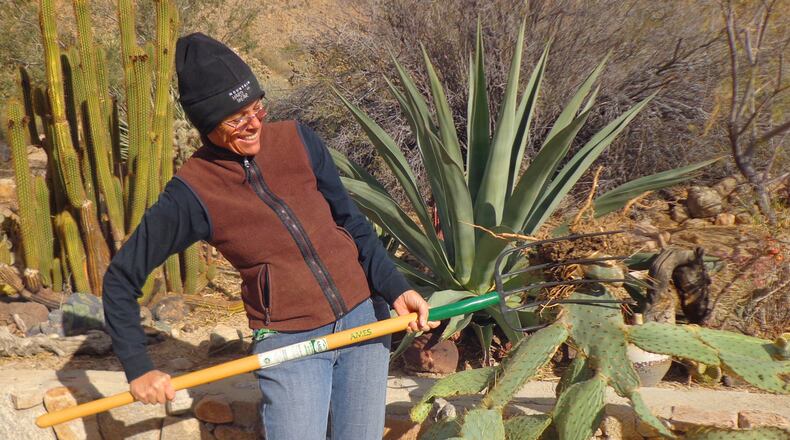Out west, fall is the best time to move big cactus and succulents. The days are growing shorter, so they are dormant from the rigors of a long hot summer. Moisture content is lower inside the plants, so they are lighter weight for us to carry. Dehydration has slowed root growth to a crawl as temperatures decline. Move cactus now, and they have all winter to adapt and flourish with the rains.
These big old plants are valuable and pricey to replace. Often homes have great old cactus or succulents such as agaves in the wrong place. Today they deserve a high profile location. Maybe they’re too close together and causing injury, so one must go to make room for the other. Perhaps you’re adding a deck or patio and things need to change. Remember: When you transplant something already on site, you are gardening the old school way instead of running out to buy something new.
Here’s a basic how-to using a 2-foot-tall barrel cactus conflicting with a big agave that had cut off southern light and stealing moisture. Moving the barrel back into full sun as a stand alone plant will save its life. Here are the basics:
1. Before your start, use chalk or marker to identify the side of the plant facing north. It will guide your orientation in the new location. It may help to mark the soil level on your plant too for a depth guide when replanting.
2. Gently remove soil from around the roots trying to keep all as intact as possible. This is more challenging in clayey soils that become very hard in late summer. Once the roots are free, cut off any that are damaged above the break point.
TIP: Try watering the area slowly overnight to soften the ground before going to work for easy release and minimized breakage.
3. Wrap the plant in a carpet remnant, particularly if it’s a tall, thin type that needs continuous support. Often, fence post cacti break under their own weight if not wholly supported. It also can protect the skin from injury during the transplant process. Tie the carpet with tape to hold in place during the entire move.
4. If you can pick up the carpet, move the plant to your new location. If it’s too heavy, use a fan belt or a circle of garden hose to make handles. These are ideal for round hard-to-grasp golden barrels often sold bare root.
TIP: Leave the roots in the open air for a few days before replanting so injuries dry out and callus off to prevent rot and disease.
5. Most cactus and succulents have shallow roots ready to catch scant rain. Thus a shallow hole is called for. Too much soil disturbance can result in lack of stability with very heavy plants under extensive rainfall the first year or two.
6. Often transplants do better when there is a rock or boulder used. They make a good counter balance or helper stone to increase stability. When used on the west side of the plant, roots find a haven underneath in the depth of summer afternoon heat. Above all, the rock provides a diffuser to facilitate watering by hand without erosion.
Note that there is no soil preparation detailed here because these plants are not heavy feeders. They are actually lovers of granular soils that drain quickly, but they are able to adapt to heavier soils on sloping ground.
Just don’t forget that weight plus armor combined equals serious injury potential. We don’t want to get stuck so we do all kinds of weird moves that result in back pain. Picking up heavy spiny plants is even scarier because if they are dropped against a leg or on a foot, there will be blood.
The greatest appeal of the succulent and cactus world is their ease of transplanting. A virtual novice can move a huge plant with just a few tips on handling. That opens the door to rearranging your property this fall with some creative transplanting projects.
———
Maureen Gilmer is an author, horticulturist and landscape designer. Learn more at www.MoPlants.com
About the Author
Keep Reading
The Latest
Featured


